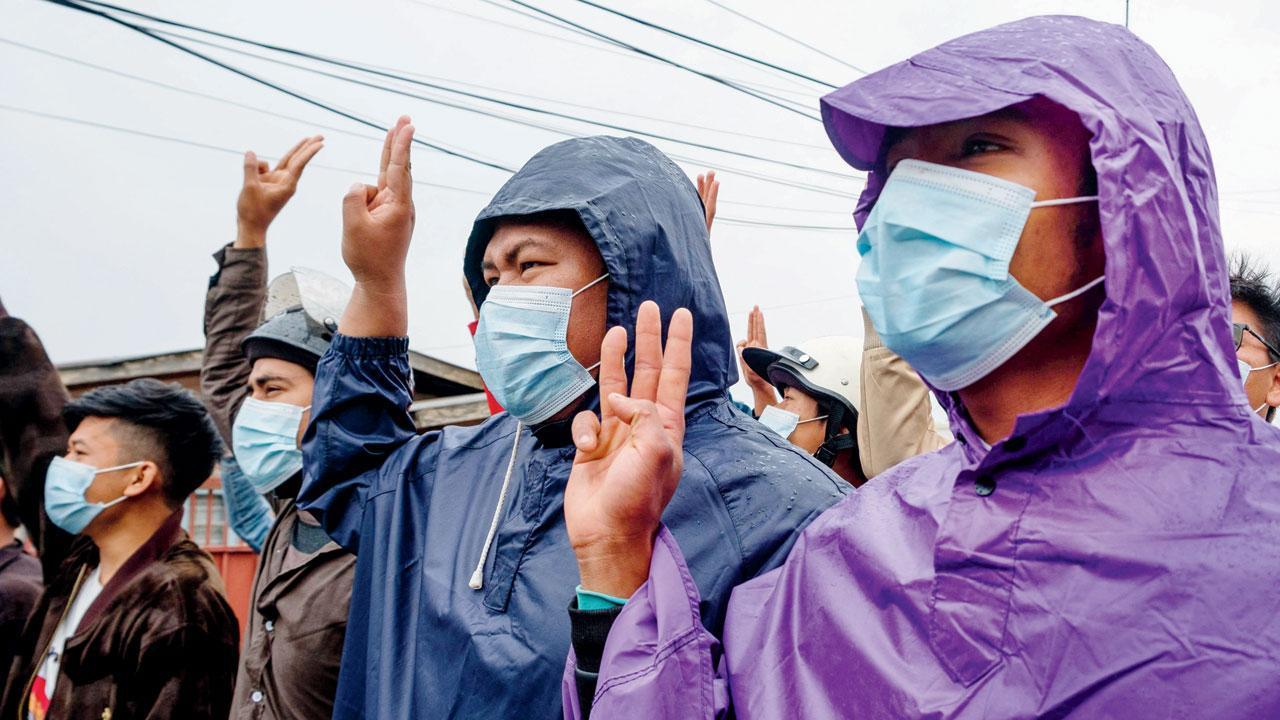Zo refugees streaming in from Myanmar are largely Christian. Sheltering them is not only the morally right thing to do, but also a way for the Centre to show it cares as much about them, and thereby the Northeast, as it does about Hindus

Protesters make the three-finger salute during a demonstration against the military coup in Taunggyi in Myanmar’s Shan state on Sunday. Pic/AFP
The assault on Capitol Hill by Trump’s supporters in January had Indian media spend days analysing the dramatic event. Contrast that with its indifference to the brutal military suppression of Myanmarese protesting against the coup in their country. Myanmar was largely forgotten until Mizoram Chief Minister Zoramthanga publicly disagreed with the Union Government’s advisory asking Mizoram, Manipur, Nagaland and Arunachal Pradesh to prevent those fleeing the Myanmarese military, known as the Tatmadaw, from entering India.
Zoramthanga wrote a letter to Prime Minister Narendra Modi, saying India could not turn a blind eye to the humanitarian crisis unfolding in Myanmar because those escaping from the Tatmadaw’s bloodied claws were the Zo people. The term Zo refers to India-Myanmar borderland tribes – Chin, Mizo, Kuki, Zomi, etc. – who believe, as academician Pum Khan Pau says, in the “myth of a common origin called Khul or Chhinlung or Sinlung (a cave whose whereabouts remain a mystery).” For Mizos to turn away Chins, or inhabitants of Chin State in Myanmar, is akin to sending their own people to certain death.
ADVERTISEMENT
Neither the Indian civil society nor the government shares the mounting disquiet in the Northeast over Myanmar. They are, instead, fixated on the possibility of Myanmarese flooding India, evident from the Manipur government’s letter asking officials to not establish camps for them – and politely turn them away. Although the letter was subsequently withdrawn, India appears depressingly different from what it was three decades ago.
Then, during the 1988-90 democratic uprising in Myanmar, India hosted hundreds of Myanmarese refugees. The Indian embassy in Rangoon (now Yangon) provided assistance to political activists. Foreign Minister PV Narasimha Rao gave an undertaking to a parliamentary panel that no Burmese refugee would be turned away from India. Delhi deftly played both ways – it did not publicly oppose the military junta, but allowed the National League for Democracy to establish an office in Delhi and the All India Radio to broadcast a popular programme for Myanmarese against the military.
In November 1990, two Myanmarese youth hijacked a Thai Airways plane to Kolkata to draw international attention to Myanmar. After they were arrested, 38 MPs wrote to then Prime Minister Chandra Shekhar asking for their release. They were bailed out three months later. One of the two hijackers was Soe Myint, who on his release set up Mizzima News, a go-to website in the current political turmoil. Unlike today’s insular Opposition leaders, then we had George Fernandes, whose residence throbbed with Myanmarese plotting to revive democracy.
Underlying India’s silence today is its paranoia of the immigrant or the outsider, a term mythicised by the Hindutva brigade to efface all distinctions among people in this category, for demonising them. But the Myanmarese who slips past the hawk-eyed, trigger-happy Tatmadaw is not an immigrant but a refugee compelled to escape to India to save his or her life. This point was tacitly accepted by the judiciary three decades ago, although India then as now was not a signatory to the 1951 United Nations Convention on the Status of Refugees.
It so happened that the Myanmarese who fled their country in the bloody aftermath of the 1988-90 uprising were housed in camps in Mizoram and Manipur. Many were jailed as they sought to come out from these camps. Lawyer and writer Nandita Haksar took their cases to the Guwahati High Court and the Supreme Court, which ordered that the incarcerated Myanmarese be placed under the protection of the United Nations High Commissioner for Refugees. The UNHCR gave them identity cards and stipends – and subsequently resettled them in other countries.
Delhi has forgotten this precedent in its paranoia about the “probability of large-scale illegal influx into Indian territory” through the porous Indo-Myanmar border. This is a telling commentary on the diminishing of India’s democratic spirit under the Modi government, which enacted the Citizenship Amendment Act on the basis of its own tendentious narrative that only Afghanistan, Pakistan and Bangladesh persecute non-Muslim minorities, essentially Hindus, whom India must provide refuge and throw out the rest – the Rohingya refugees, for instance.
The Hindutva narrative subliminally also excludes the Zo people, who were cleaved apart because of the British imperiously drawing a boundary line for their own convenience. The Zo’s concern regarding their fragmentation was not taken into account when the India-Myanmar Boundary Agreement was signed in 1967. Academician Avinash Paliwal writes, “India continued with the colonial tradition of bypassing local demands…but did so…by invoking the Constitution of India that allocated foreign policy to the Union List.” Protests in the Northeast dissuaded Delhi from turning the agreement into a treaty, which would have insulated the settlement from future challenges.
In the United Nations Security Council last week, India condemned the violence in Myanmar, and expressed its commitment to democratic transition there. This position calibrates moral imperatives with the realpolitik of competing with China in Myanmar. India cannot alienate and destabilise the Northeast. A sure way of preventing it is to shelter refugees from Myanmar, thereby demonstrating Delhi has as much concern for the Zo people, most of whom are Christian, as it has for Hindus. That ‘Hindu’ is not coterminous with ‘Indian’ – not yet at least!
The writer is a senior journalist. Send your feedback to mailbag@mid-day.com
The views expressed in this column are the individual’s and don’t represent those of the paper.
 Subscribe today by clicking the link and stay updated with the latest news!" Click here!
Subscribe today by clicking the link and stay updated with the latest news!" Click here!







